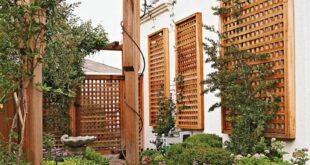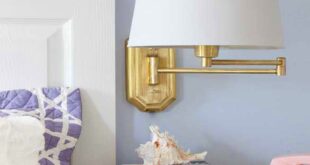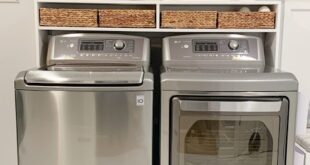


A floor to ceiling plate rack wall that looks built-in doubles as a place for decorative storage as well as a way to enhance an awkward wall that is hard to decorate. Making one for your home is easy to customize to fit a wall of any size.
Plate racks and built-in plate rack walls are not anything new in the decorating world, but for me – it’s a first.
I have always liked them, but had a large china hutch in my previous home and didn’t really need another place to display my collection of white plates, pitchers and platters.
Now, after living without a dining room and that hutch in my current home for 5 years, I miss seeing my collection and wanted to find a way to display more of it in my kitchen. I have the collection of white pitchers and soup tureens on the open shelves in my kitchen, but the platters have been hidden in my china closet.

I have the perfect wall for a floor to ceiling plate rack and made the decision to go for it.
Bye-bye chalkboard wall. I enjoyed you for the last few years, but change is a good thing, especially in decorating as our lives and tastes evolve.
For anyone who wants to know, it was easy to remove the chalkboard paint by rolling over two coats of KILZ Premium primer and then two coats of Sherwin Williams semi-gloss in the color Pure White that is on the kitchen cabinets.
There are many ways to create a plate rack wall. If you want to see just how many, do a search for “plate rack walls” on Google or Pinterest and you will see. 🙂 Inspiration abounds!

I wanted a simple classic rack where the plates would stay secure. I went with the two guard style where a strip of lattice is placed over each shelf as well as a safety rail 2″ above the lattice for each shelf.
I also chose to stop the vertical sides of the frame at the top shelf’s safety rail. If there wasn’t crown molding already at the ceiling line, I would have taken the rack all the way to the ceiling.
How to Make a Floor to Ceiling Plate Rack on a Wall

A Few Things to Consider When Making a Plate Rack Wall
Where to Hang a Plate Rack?
A plate rack can go on any wall you want. The narrow wall between my kitchen and living room was the perfect place for mine. Look around your home to see if there is wall you can build a floor to ceiling plate rack wall.
How Deep Do You Want the Shelves?
Figure out what you want to display on your rack. Do you want plates to be layered on the shelves or single. Would you like to add items besides plates and platters?
For instance cookbooks, cutting boards, candlesticks or a plant? Once you know, measure the objects to see what shelf depth will be needed to hold the items so you can buy wood that is that right depth.
I wanted simple and clean lined and went with the depth of a 2-inch shelves. I found many plate racks that used 1 x 3’s. Customize it to be just right for your needs.
What Should the Distance Be Between Shelves?
There is no right or wrong distance that should be between the shelves. Most plate racks have the same distance between each shelf, but since you are custom making one, you get to decide what the space between the shelves should be.
Figure out what items you want to display on your rack to come up with how much space there should be. For my rack, I like the look of a larger space on the bottom that gradually gets smaller with each shelf as you move to the top.
I made the bottom two shelves 17-inches apart. The space between the shelves after these get smaller by an inch. 17″ – 17″- 16″- 15″- 14″ 13″.
What Style Plate Guard Rail Do You Like?
You can use a few different things for the plate guard rails. Lattice strips, screen molding, dowels, even metal pipe.
How Will You Attach It To Your Wall?
After looking at quite a few plate racks on Pinterest, I decided that I would have to build my rack on the floor first and then attach to the wall.
I had to do it this way since the wall my rack went on is hollow. My rack has a built-in look, but you can hang a smaller rack using picture hangers.
Step-By Step: Building a Plate Rack Wall
The wall my rack is on is hollow. To make sure I could securely attach it, I made the outer frame on my worktable and then moved it to the wall. Once the frame was secure on the adjacent wall using long wood screws, I added the shelves.
Option: Depending on your wall, you can build the frame right in place on the wall.
supplies needed:
- 1 x 2 primed boards
- 1 – 1/4″ primed lattice strip
- 1 inch screen molding – flat not ribbed
- Mitre or circular saw
- Tape Measure
- 2″ wood screws
- Brad nail gun and 2-inch brad nails or hammer and finishing nails
- If using a hammer and nails, Nail punch to countersink nails.
- Bubble level
- Paint – Sherwin Williams Pure White -semi-gloss
- 1″ angled paint brush
- Small paint roller
- Spackle
- Caulk
- Painter’s tape
- 100-grit sandpaper
Time needed: 5 hours.
How to Make a Floor to Ceiling Plate Rack on a Wall That Looks Built In
- Measure Wall Space
Measure the area on the wall where you would like the plate rack to be.
Figure out how many shelves you want your rack to have. One way to determine this is to gather what you are going to display on the rack and measure the sizes to make sure they will fit where you envision them going.
For instance, I wanted larger items at the bottom and smaller at the top of my rack, so I made the space between the bottom two shelves 17 inches. After these measurements, the space between the rest of the shelves is one inch less for each shelf.

- Sketch Out Your Plan
Once you know your measurements and the amount of shelves needed, draw out your rack plan on paper to figure out how much wood you will need to buy.

- Vertical Wood Height
When figuring out the distances between the shelves, don’t forget to figure in what length the vertical outer frames pieces of wood should be so the top safety rail is flush with them when you add the shelves.

- Assemble Frame
Lay out the cut to size 1 x 2’s on your work table and create the outer frame using 1′ x 2’s.
Next: Measure the distance between the inside edge of the left and right 1 x 2’s and cut two 1 x 2’s for the bottom of the frame which is the bottom shelf and one for the top shelf.
Attach one side of each shelf to the frame. The other side of each will be attached once you hang it on the wall where you will be able to level each one before securing.

- Use a Countersinking Drill Bit
When attaching frame and shelves together, use a countersinking drill bit to recess the heads of the screws.

- Repeat for Each Shelf

- Move Frame to Wall
Once you have your outer frame made with the one end of each shelf attached, move it to the wall and secure to the wall.

- Use Wood Screws to Attach to the Wall
I used 2″ and 3″ wood screws to attach the frame to walls.

- Attach Horizontal Shelves
Place the first shelf piece of wood inside the frame. Make sure it is level before securing it to the wall with brads or nails. Countersink all nails.

- Spackle, Caulk and Paint the Frame and Shelves
Spackle over areas where you countersunk any nails. Caulk around edges if needed. Paint the plate rack frame and shelves. Let dry.

- Add Guard Rails
To determine how wide to make the front guard piece (lattice) and the safety rail (screen molding), measure from the outside edge of the frame.
Cut both the 1 – 1/4″ lattice strip and the 1″ screen molding to this measurement. You will need one of each for each shelf. Sand cut edges smooth.

- Attach the Guard Piece
Attach the 1 – 1/4″ lattice. To do this, place the lattice over the horizontal 1 x 2 shelf so that the bottom of the lattice is flush with the bottom of the horizontal 1 x 2 shelf. Attach with finishing nails, countersink if necessary. Repeat this process for each shelf.

- Attach the Safety Rail
Place a 1″ piece of screen molding 2″ up from the top of the lattice. Attach with finishing nails.

- Paint the Front Guards and Safety Rails
If needed, Spackle and caulk, then paint. Let dry.

- Place Plates and Platters
Once the paint touch-ups are dry, fill your rack with your collection of plates, platters and other items.


I have been looking for a large round cutting board for a long time that didn’t cost a fortune. I bought this one last week at Kirklands. It has a checkerboard pattern on the reverse side, but no one will ever see that. I may even sand the board to make it look aged.

I am planning on making a smaller bread board to add to the bottom shelf and maybe even adding a clock face to one shelf like in the photo above.
You can find clock faces like this in My Free Printable Library.
You May Also Like:




